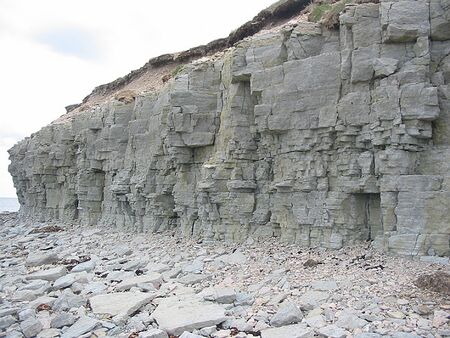Limestone
Limestone is an organic sedimentary rock which is composed of fossils of sea organisms.
Definition
Limestone is an organic sedimentary rock which is composed of fossils of sea organisms. Most of the times that fossils are discovered in a rock type it is said that this rock type is limestone. In most cases this is true, but there are some exceptions. Some exceptions can be found elsewhere on this page. Limestone consist mainly of calcium carbonate and due to that it is a very soft rock type. Moreover it can be recognized by its solubility in hydrochloric acid.
Characterization
Most limestones have a granular texture. Their constituent grains range in size from 0.001 mm to visible particles. In many cases, the grains are microscopic fragments of fossil animal shells. A limestone can have two origins. The first when clasts of an existing limestone are transported and deposited in a clastic deposit. The second origin is via precipitation from seawater. [1] There are some varieties of limestone which are given another name. All are described below.[2]
Calcarenite
Calcarenite is a type of limestone that is composed predominantly, more than 50 percent, of detrital sand-size (0.0625 to 2 mm in diameter), carbonate grains. The grains consist of sand-size grains of either corals, shells, ooids, intraclasts, pellets, fragments of older limestones and dolomites, other carbonate grains, or some combination of these. [3]
Calcilutite
Calcilutite is a type of limestone that is composed of predominantly, more than 50 percent, of either clay-size or both silt-size and clay-size detrital carbonate grains. These grains consist either of fossil fragments, ooids, intraclasts, pellets, other grains, or some combination of them. [3]
Calcirudite
Calcirudite is a type of limestone that is composed predominantly, more than 50 percent, of carbonate grains that are larger in size than sand (2 mm in diameter). The grains can consist of either fragments of fossils, fragments of older limestones and dolomites, other carbonate grains, or some combination of these. [3]
Calcisiltite
Calcisiltite is a type of limestone that is composed predominantly, more than 50 percent, of detrital silt-size carbonate grains. These grains consist either of the silt-size particles of ooids, fragments of fossil shells, fragments of older limestones and dolomites, intraclasts, pellets, other carbonate grains, or some combination of these. [3]
Chalk
A soft limestone with a very fine texture that is usually white or light gray in color. It is formed mainly from the calcareous shell remains of microscopic marine organisms such as foraminifers, or the calcareous remains from numerous types of marine algae.
Coquina
A poorly-cemented limestone that is composed mainly of broken shell debris. It often forms on beaches where wave action segregates shell fragments of similar size.
Fossiliferous Limestone
A limestone that contains obvious and abundant fossils. These are normally shell and skeletal fossils of the organisms that produced the limestone.
Lithographic Limestone
A dense limestone with a very fine and very uniform grain size that occurs in thin beds which separate easily to form a very smooth surface. In the late 1700s, a printing process (lithography) was developed to reproduce images by drawing them on the stone with an oil-based ink and then using that stone to press multiple copies of the image.
Oolitic Limestone
A limestone composed mainly of calcium carbonate "oolites," small spheres formed by the concentric precipitation of calcium carbonate on a sand grain or shell fragment.
Travertine
A limestone that forms by evaporative precipitation, often in a cave, to produce formations such as stalactites, stalagmites, and flowstone.
Tufa
A limestone produced by precipitation of calcium-laden waters at a hot spring, lake shore, or other location.
Limestones with shells
Limestone is a sedimentary rock composed mainly of calcium carbonate (CaCO3), usually calcite, sometimes aragonite. It may also contain considerable amounts of magnesium carbonate (dolomite, (CaMg)(CO3)2). Most limestones have a granular texture, but limestone can also be massive, crystalline or clastic. Most limestones are formed by the deposition and consolidation of the skeletons of marine invertebrates. Shell limestone consists mainly of shells of marine organisms like brachipods, clams, oysters, etc.
Limestones with crinoids
Crinoids were creatures living on the seafloor and consist of large tentacles which could reach up to meters. Sea stars and sea cucumbers are also present in this category of organisms. Their fossils can be found in for example limestones. The can even be the supporting clast of a rock type, these are called encrinites. A crinoid is very distinguish. It could be a large tentacle present in the rock or you see the top of this tentacle which is hollow on the inside and round on the outside.
Limestones with nummulites
A nummulite is a large lenticular fossil, characterized by its numerous coils, subdivided by septa into chambers. They are the shells of the fossil and present-day marine protozoan Nummulites, a type of foraminifera. Nummulites commonly vary in diameter from 1.3 cm to 5 cm and are common in Eocene to Miocene marine rocks.
Limestone with nummulites image
References
- https://www.britannica.com/science/limestone
- https://geology.com/rocks/limestone.shtml
- Grabau, A.W. (1904) On the classification of sedimentary rocks. American Geologist. vol. 33, pp. 228-247
Limestone

| Group | Organic sedimentary rock |
| Texture | Clastic or non-clastic |
| Clasts | Broken fragments can be visible |
| Hardness | Hard |
| Color | White-to-gray or yellow |
| Minerals | Calcite |
| Touch | Smooth to rough |
| Image | Limestone |
|---|














